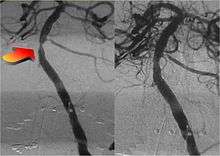Interventional neuroradiology
Endovascular surgical neuroradiology (ESN), commonly known as interventional neuroradiology, is an Accreditation Council for Graduate Medical Education (ACGME) accredited medical subspecialty specializing in minimally invasive image-based technologies and procedures used in diagnosis and treatment of diseases of the head, neck, and spine. While ESN programs can be ACGME accredited, fewer than five programs in the U.S. are accredited. The number of physicians in the United States with an active interest and special competency in this field is estimated to be around 600.
History
The technique that constitutes the basis for angiographic neurointerventions, and thus, interventional neuroradiology, was first developed in 1927 by the Portuguese physician Egas Moniz at the University of Lisbon to provide contrasted x-ray angiography in order to diagnose several kinds of nervous diseases, such as tumors, coronary heart disease and arteriovenous malformations. He is usually recognized as one of the pioneers in this field. Moniz performed the first cerebral angiogram in Lisbon in 1927.
Diseases and conditions


The following is a list of diseases and conditions typically treated by neurointerventionalists.
- Cerebral aneurysm
- Brain arteriovenous malformation (AVM)
- Carotid-cavernous fistula (CCF)
- Dural arteriovenous fistula
- Extracranial (brachiocephalic) atherosclerosis
- Extracranial (head and neck) and paraspinal vascular malformations
- Head and neck tumors
- Intracranial atherosclerosis
- Juvenile nasopharyngeal tumor
- Meningiomas
- Nosebleeds
- Paragangliomas
- Stroke
- Spinal vascular malformations
- Traumatic vascular lesions
- Vasospasm
- Vertebral body tumors
- Vertebral body compression fractures